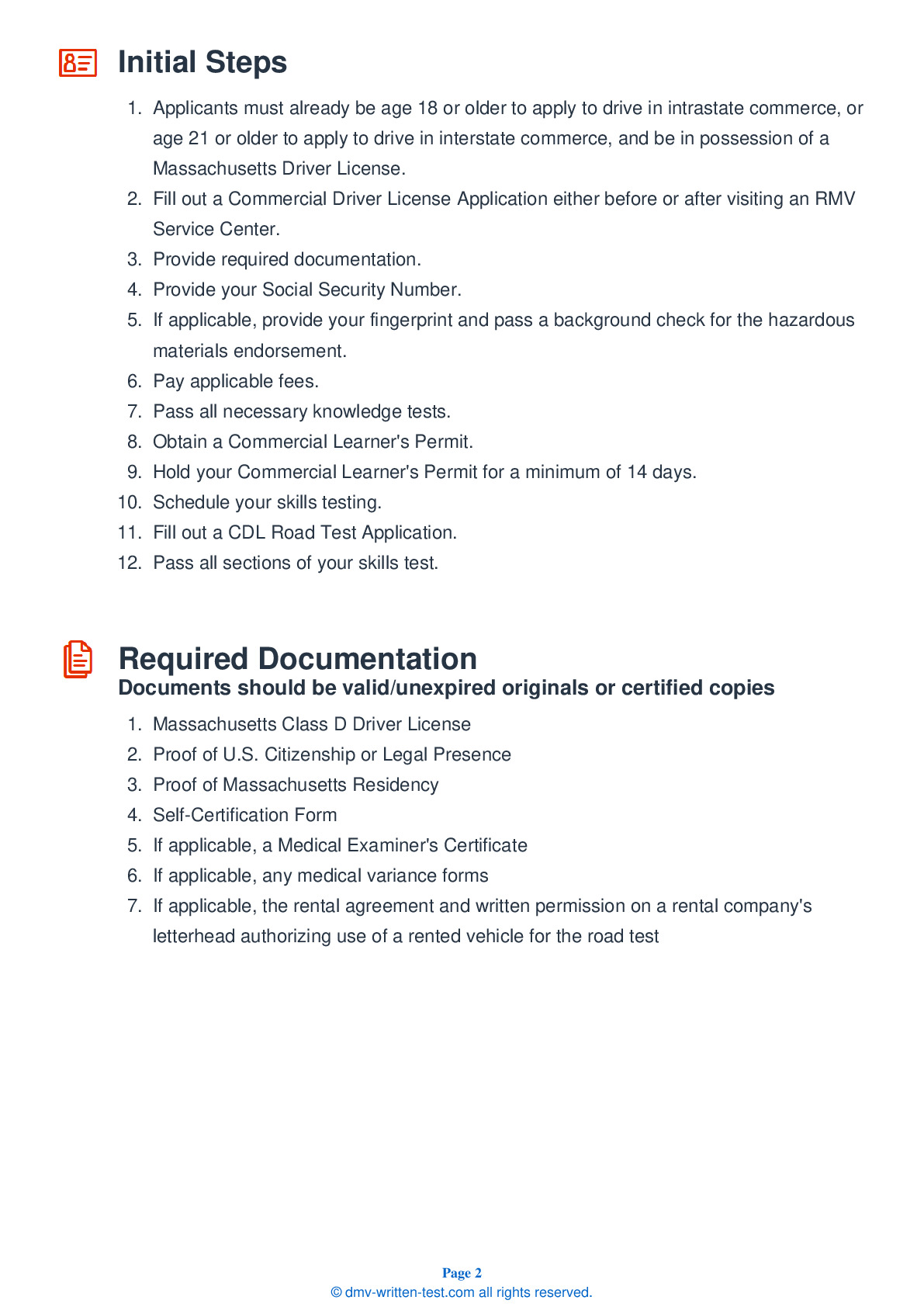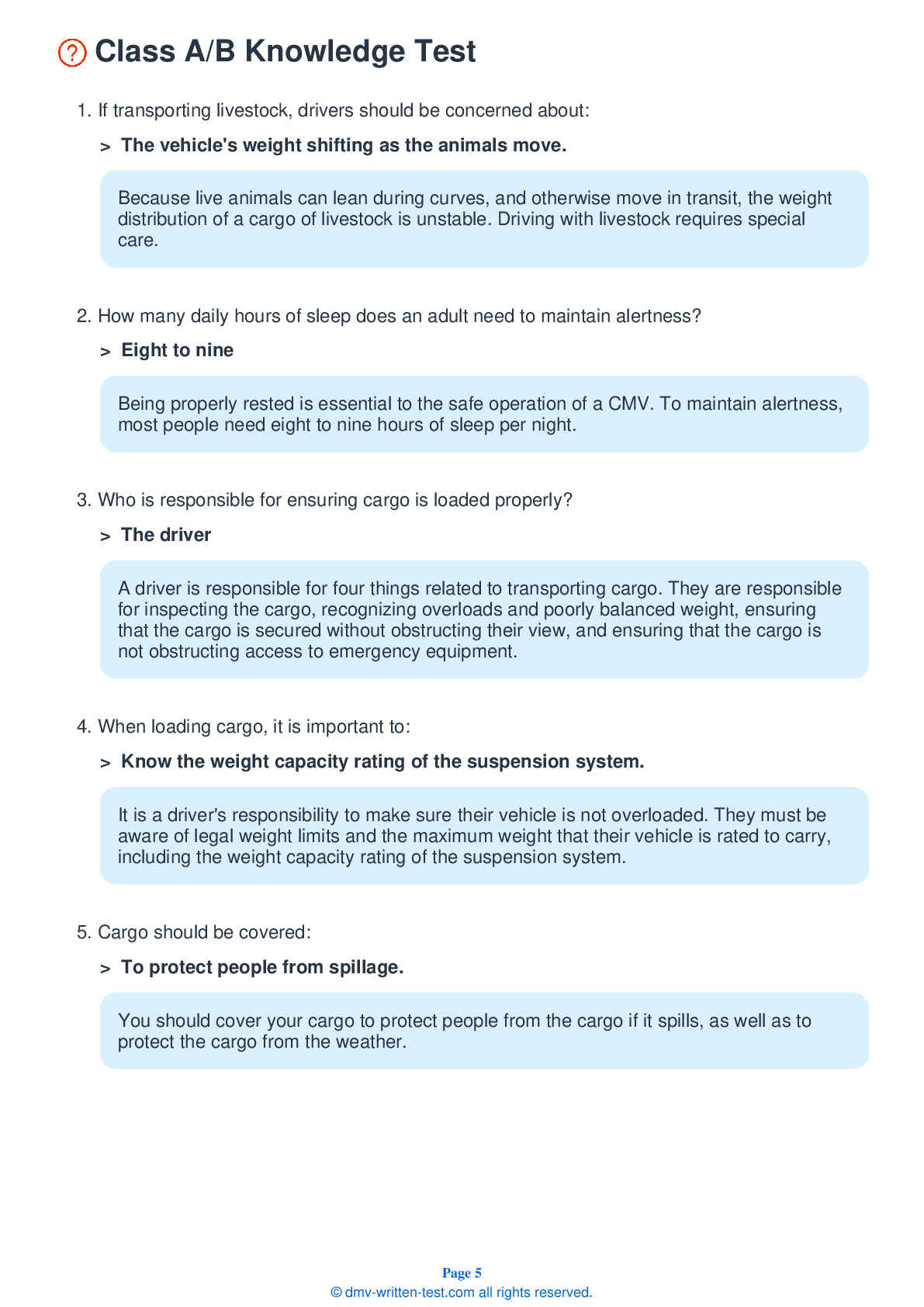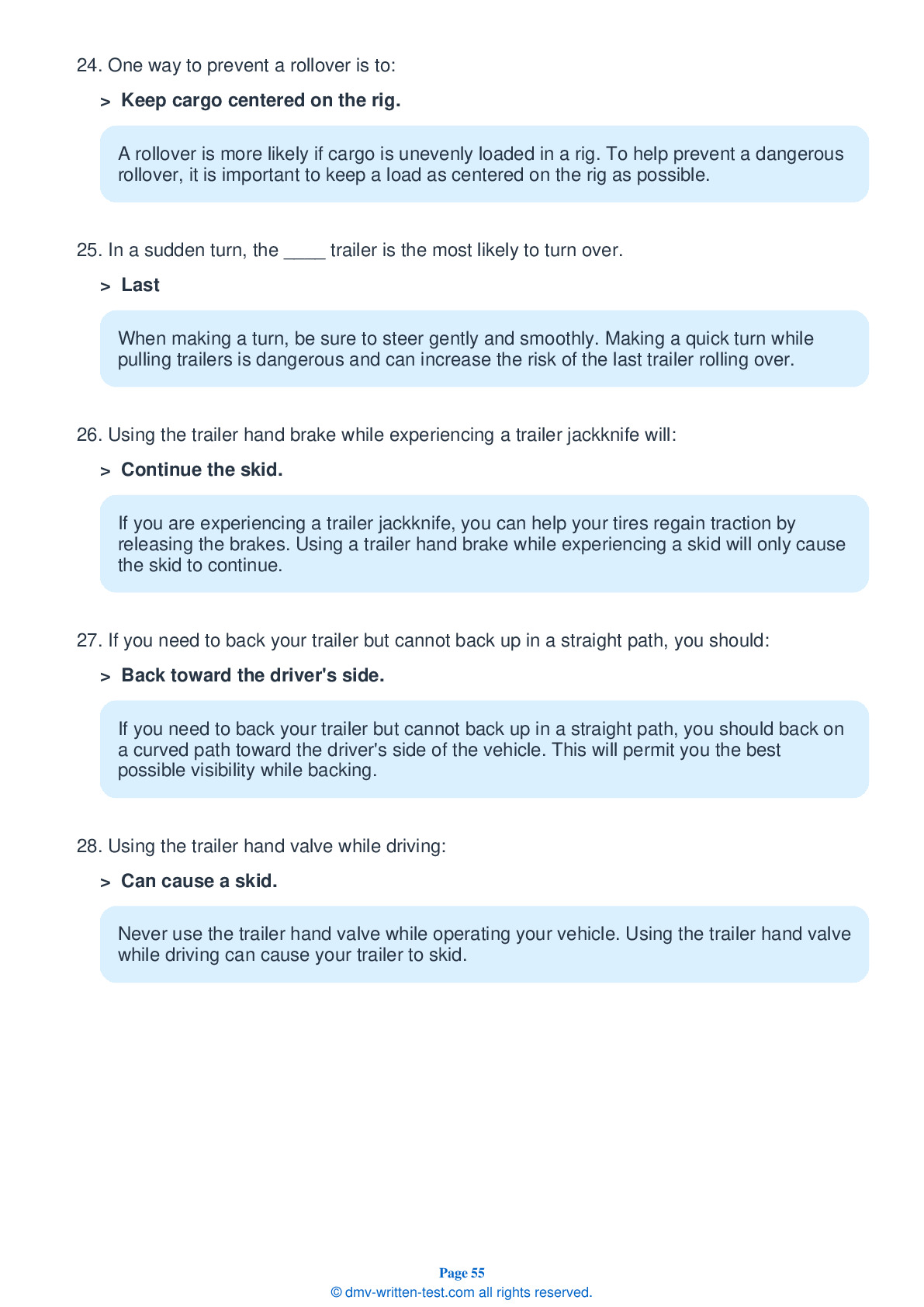Knowledge Test Class B
This license is required for driving a single vehicle with a GVWR of more than 26,001 pounds, and a trailer not to exceed 10,000 pounds gross vehicle weight rating, or a vehicle designed to transport 24 or more people (including the driver). To receive this license, applicants must pass a 50-question test. To pass, applicants must answer 40 questions correctly. Each question has four possible answer choices. Test questions come from the Commercial Driver License Manual. Questions come from chapters covering: Introduction, Driving Safely, Transporting Cargo Safely, Air Brakes (if applicable), Pre-Trip Vehicle Inspection Test, Basic Vehicle Control Skills Test and On-Road Driving.. Endorsements that may be used with a Class B CDL are: Hazardous materials, Tank, Passenger, HazMat and Tank, Air Brakes and School bus.
1. An air brake-equipped vehicle traveling at a speed of 55 mph under ideal driving conditions will need approximately ____ to come to a complete stop.
A vehicle's total stopping distance is made up of perception distance, reaction distance, brake lag distance, and braking distance. With all of these factors included, an air brake-equipped vehicle traveling at a speed of 55 mph under ideal driving conditions will need approximately 450 feet to come to a complete stop.
2. What should you do if the brake pedal does not build up pressure?
If you lose pressure in a hydraulic brake system, one appropriate response is to shift down into a lower gear. This will help slow the vehicle.
3. In a convex mirror, objects seem ____ than they actually are.
A convex mirror makes objects seem smaller and farther away than they actually are.
4. Federal and state laws require:
Commercial drivers are required by federal and state laws to inspect their vehicles before every trip. Regular inspections can help drivers identify issues before they become dangerous and costly.
5. When passing another vehicle, you should:
Whenever you pass another driver, bicyclist, or pedestrian, you should assume as a precaution that they do not see you.
6. If a vehicle is equipped with power steering, the hoses should be checked:
When inspecting a vehicle that is equipped with power steering, check the hoses, pumps, and fluid level. In particular, you should look for leaks in the hoses.
7. If your truck or trailer catches fire, you should:
If there is a fire in your vehicle, the first thing you need to do is leave the road and stop. Park in an open area away from anything that could catch fire, such as plants or other vehicles. Do not pull into a service station.
Frequently Asked Questions
To obtain a Class B CDL in Massachusetts, a driver must first pass a written test and obtain a learner's permit. The driver must then complete a minimum of 40 hours of behind-the-wheel training and pass a road skills test. Additionally, the driver must pass a medical examination and meet other requirements such as being at least 18 years old and having a clean driving record.
Renewal of the Class B CDL in Massachusetts is required every 5 years and involves passing a vision test and paying the renewal fee. The driver may also be required to complete continuing education or training to maintain the license.
1. Single vehicles with a weight of 26,001 pounds or more.
2. Combination of vehicles with a total weight of 26,001 pounds or more, provided that the vehicle being towed weighs less than 10,000 pounds.
3. Large buses such as school buses, city buses, and tourist buses.
Some examples of vehicles that you can operate with a Class B CDL include delivery trucks, dump trucks, concrete mixers, and tow trucks. Generally speaking, any commercial vehicle that exceeds 26,000 pounds and does not have more than one trailer can be operated with a Class B CDL.
It is important to note that additional endorsements may be required to operate certain types of commercial vehicles. For example, if you want to drive a bus with air brakes or more than 16 passengers, you will need to obtain an additional endorsement on your CDL.
1. Be at least 18 years old: You must be at least 18 years old to drive within the state of Massachusetts and at least 21 years old to drive across state lines or transport hazardous materials.
2. Have a valid driver's license: You must have a valid Massachusetts driver's license.
3. Pass a medical examination: You must pass a medical examination and have a valid medical certificate.
4. Pass the written knowledge test: You must pass a written test on the rules and regulations of commercial driving.
5. Obtain a learner's permit: You must obtain a learner's permit to practice driving before taking the road skills test.
6. Complete behind-the-wheel training: You must complete a minimum of 40 hours of behind-the-wheel training with an approved commercial driving school or with an employer who provides training.
7. Pass the road skills test: You must pass a road skills test that includes a pre-trip inspection, basic control skills, and an on-road driving test.
8. Pay the applicable fees: There are fees associated with obtaining and renewing your Class B CDL in Massachusetts, which vary depending on your age and other factors.
It is important to note that additional endorsements may be required to operate certain types of commercial vehicles, such as buses or vehicles with air brakes.
It is important to note that age is just one of the requirements for obtaining a Class B CDL. You must also meet other requirements, such as passing a medical examination, passing a written knowledge test, obtaining a learner's permit, completing behind-the-wheel training, passing a road skills test, and paying the applicable fees.
Some of the endorsements that may be required include:
1. Passenger endorsement (P): Required if you plan to drive a vehicle designed to transport 16 or more passengers, including the driver.
2. School bus endorsement (S): Required if you plan to drive a school bus.
3. Hazardous materials endorsement (H): Required if you plan to transport hazardous materials.
4. Tanker endorsement (N): Required if you plan to transport liquids or gases in bulk containers with a capacity of 1,000 gallons or more.
5. Double/triple trailer endorsement (T): Required if you plan to tow double or triple trailers.
To obtain an endorsement, you must pass a written knowledge test and in some cases, a skills test. There may be additional requirements for certain endorsements such as background checks and fingerprinting. It is important to check with the Massachusetts Registry of Motor Vehicles (RMV) for specific requirements and regulations related to endorsements for a Class B CDL license.
1. Pre-trip inspection: You will be asked to inspect your vehicle and identify any potential safety hazards or mechanical issues. You will need to explain to the examiner what you're looking for and why it's important to address these issues before driving.
2. Basic vehicle control: You will be tested on your ability to control the vehicle in a controlled setting. This may include backing up, turning, and parking the vehicle in a designated area.
3. On-road driving: You will be required to demonstrate your ability to safely operate the vehicle on public roads. You will be evaluated on your ability to follow traffic laws, make proper lane changes and turns, respond appropriately to road signs and signals, and maintain control of the vehicle in different traffic conditions.
It's important to note that you must have a valid learner's permit for at least 14 days before taking the Class B CDL skills test. Additionally, you must provide a vehicle that meets the requirements for a Class B CDL and have proof of insurance before taking the test.
It is highly recommended that you practice extensively before taking the skills test in order to increase your chances of passing.
1. Operating a commercial motor vehicle (CMV) with air brakes: If you do not pass the air brakes knowledge test or the skills test in a vehicle equipped with air brakes, you will receive an air brake restriction on your license. This means you are not authorized to operate a CMV with air brakes.
2. Passenger endorsement restriction: If you do not pass the passenger endorsement knowledge test or the skills test, you will receive a passenger endorsement restriction on your license. This means you are not authorized to operate a CMV designed to transport 16 or more passengers, including the driver.
3. School bus endorsement restriction: If you do not pass the school bus endorsement knowledge test or the skills test, you will receive a school bus endorsement restriction on your license. This means you are not authorized to operate a school bus.
4. Hazardous materials (Hazmat) endorsement restriction: If you do not pass the Hazmat endorsement background check or the knowledge test, you will receive a Hazmat endorsement restriction on your license. This means you are not authorized to transport hazardous materials.
5. State-specific restrictions: Each state may have its own restrictions and limitations for Class B CDL drivers. It's important to check with your state's Department of Motor Vehicles (DMV) for specific requirements and regulations related to Class B CDL licenses.
It's important to note that violating any of these restrictions or limitations may result in fines, penalties, and suspension or revocation of your CDL license.
In Massachusetts, the Class B CDL written test is available in English and Spanish. However, if you would like to take the test in a language other than English or Spanish, you will need to bring an interpreter with you.
The interpreter must be fluent in both English and the other language, and must not be related to you. The interpreter will need to sign an affidavit stating that they will accurately translate the questions and your answers on the test.
It's important to note that the interpreter is not allowed to explain or clarify any questions on the test, nor can they give you any answers. They are simply there to translate.
If you have any questions about taking the Class B CDL written test in a language other than English or Spanish, it's recommended that you contact your local RMV (Registry of Motor Vehicles) office for more information.
You will need to contact the RMV's Medical Affairs Branch to request accommodations. They will provide you with a Medical Examination Report and Vision Screening Form that must be completed by a licensed medical professional.
The completed forms must be submitted to the RMV's Medical Affairs Branch, along with documentation of your disability and a request for specific accommodations. Some common accommodations that may be provided include:
- Extra time to complete the test
- A private testing room
- A reader or scribe
- Braille or large print test materials
- An oral test
It's important to note that accommodations will only be provided if they do not fundamentally alter the nature of the test or give you an unfair advantage over other test-takers.
If you have any questions about requesting accommodations for the Class B CDL written test, it's recommended that you contact the RMV's Medical Affairs Branch for more information.
First, you will need to wait a certain amount of time before retaking the test. In Massachusetts, you must wait at least one day before taking the test again. However, it's important to note that if you fail the test three times, you will need to wait at least two weeks before taking it again.
Second, there may be a fee for retaking the test. In Massachusetts, there is a $30 fee for each attempt at the Class B CDL written test.
Finally, if you fail the test multiple times, it may be a sign that you need additional study or preparation before attempting it again. There are many resources available to help you prepare for the test, including online study guides and practice tests, as well as in-person training courses.
If you have any questions about retaking the Class B CDL written test in Massachusetts, it's recommended that you contact your local RMV (Registry of Motor Vehicles) office for more information.




